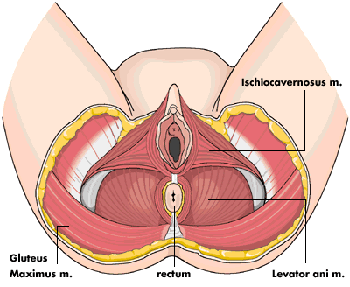September 02, 2010
Much ado about "levator microtrauma": Do epidurals protect the pelvic floor?
By: Amy M. Romano, RN,CNM | 0 Comments

The levator ani is a muscle, not a clinical outcome.
Ok, ok, I've heard from enough of you about the study purportedly showing that epidurals protect the pelvic floor, I suppose it's time to write up what I think about it. First, a little about the study from the (overzealous) journal press release. I couldn't resist doing a little bit of [line editing] on it:
Researchers from Australia undertook a prospective study of 488 women undergoing their first pregnancy between May 2005 and February 2008. The object of the study was [to determine predictors of delivery mode, but since they had enrolled all of those pregnant women they designed some other studies, too. In one, the researchers invited those 488 women to return for follow up at 3-4 months and retrospectively analyzed data on the 367 women who did] to determine if there are any risk factors during birth which may result in levator trauma including macrotrauma (large scale avulsion tearing) and microtrauma (damage to the muscle tissues such as irreversible overdistention of the pelvic floor opening). Researchers believed that the findings from their study may help modify obstetric practice to help prevent levator injury...No levator avulsion was recorded in the women who had a caesarean section. Levator avulsion was diagnosed in 13% of women who had a vaginal birth (9% of whom had had a vacuum delivery and 35% of whom had had a forceps delivery). Researchers found that forceps delivery was associated with a three to four-fold increase in levator avulsion. [They excluded the 13% of vaginal births in which levator avulsion was diagnosed and evaluated the rest of the women for "microtrauma". We put "microtrauma" in quotes because no one has ever defined or determined the prevalence of this "condition". The researchers invented it themselves! But anyway,...] Postbirth assessment showed that the longer the 2nd stage of labour, the higher the likelihood of microtrauma. Women who had an intrapartum epidural were found to have had a lower incidence of microtrauma. The researchers suggest that epidurals, because they relax the muscles through paralysis, may be beneficial in preventing levator trauma.
There are multiple problems with the press release and, for that matter, with the study itself. Christine Kent at Whole Woman Village Post does a nice job of reviewing some of them, including the fact that one of the study authors receives money from incontinence surgical device companies and ultrasound companies. But I'd like to focus on the use of "levator microtrauma" as the outcome reported.
Levator microtrauma is an example of a surrogate outcome(sometimes referred to as a surrogate endpoint). As defined by Temple (1995):
A surrogate endpoint of a clinical trial is a laboratory measurement or a physical sign used as a substitute for a clinically meaningful endpoint that measures directly how a patient feels, functions or survives. Changes induced by a therapy on a surrogate endpoint are expected to reflect changes in a clinically meaningful endpoint. [emphasis mine]
But as D'Agostino (2000) argues, some surrogate outcomes are extremely poor predictors of actual outcomes, and changing clinical practice based on studies that report only surrogate outcomes can be a major threat to patient safety if the therapy introduces other risks. So the questions we should ask ourselves when we see a study reporting a surrogate outcome are:
- is the surrogate outcome a good predictor of a clinically important outcome (i.e., "how a patient feels, functions or survives")?
- does the treatment pose any excess risks over other alternatives to achieving that clinically important outcome?
In the case of "levator microtrauma," there is absolutely no data whatsoever linking the author's definition of microtrauma to pelvic organ prolapse or other important pelvic floor problems such as incontinence or sexual dysfunction. The aforementioned corporate-sponsored researcher showed in an earlier study thatmacrotrauma (aka levator avulsion) is an appropriate surrogate for pelvic organ prolapse, but remember thatepidurals were not associated with macrotrauma in this study. Forceps deliveries were - and what's the major modifiable risk factor for forceps delivery? Epidurals!
But let's say that microtrauma does lead to pelvic floor problems and that, therefore, epidural analgesia in labor may be a strategy for preventing those pelvic floor problems. Is encouraging epidural analgesia in a woman who might otherwise forgo it the best strategy for preventing pelvic floor problems? Maybe doing away with coached pushing, fundal pressure, episiotomy, and supine positioning might be the better strategy. Maybe postpartum exercises can help reverse changes associated with pregnancy and vaginal birth so they don't turn into symptomatic pelvic floor problems.
Like other studies that report surrogate outcomes, this study is not useless. It provides some data that can help us understand how epidurals affect pelvic floor muscle tone and strength and alter the process of vaginal birth, and I'll be the first to say that we need more research in those areas. In other words, these data on a novel surrogate outcome can help us design more studies, not guide patient care.
Anyone who has even a basic understanding of clinical research should recognize that we need much more data before we can say that epidurals may help prevent future pelvic floor prolapse. Oh wait, the editor-in-chief of a major international obstetric journal just said exactly that! In the headline of a major press release!
*headdesk*
Reference:
Temple RJ. A regulatory authority's opinion about surrogate endpoints. Clinical Measurement in Drug Evaluation. Edited by Nimmo WS, Tucker GT. New York: Wiley; 1995.
Tags
Interventions Pelvic Floor Safety Bias Labor/Birth Epidurals Surrogate Outcome